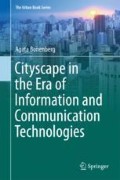Abstract
Traditionally, urban public spaces integrated inhabitants of a city. It provided the setting for the “space of access to information”, and this characteristic was often expressed in the architecture with elements of visual information: inscriptions, sculptural detail of the “communicative” role. Symbolism of hierarchy was expressed by the dominants of sacral and secular buildings. As mass communication takes over, the fact of “detachment” of communication from a real space becomes a fact, and it remains not without consequences on the space.
Access this chapter
Tax calculation will be finalised at checkout
Purchases are for personal use only
Notes
- 1.
Aristoteles as the first wrote about a human: Man is by nature a social animal; an individual who is unsocial naturally and not accidentally is either beneath our notice or more than human, “Politics”, about 328 before Christ.
- 2.
It was a realistic proposition because the first underground railway in the world, the London underground, had already been used then for about thirty years. The first section of the subway was opened in 1863. Therefore, author’s ideas went hand in hand with the technical capabilities of the era. The premises of the Linear City’s authors can thus be classified as real.
- 3.
An exception are multimillion metropolises where operate issuers of local mass media: regional television programs, radio channels, internet portals and traditional press.
- 4.
- 5.
Computational design allows the generation of architectural forms using digital optimization methods, in which the architect controls the form using a programming code.
- 6.
The problem of fragmentation of the city is associated with the increasing trend of spatial divisions in cities: social, economic, cultural and political ones. The phenomenon is socially harmful because it highlights differences between the inhabitants—generating conflicts and, generally, increased crime (Graham and Marvin 2001).
References
Bonenberg, A. (2013) Media, przestrzeń, architektura. Transformacje przestrzeni społeczeństwa informacyjnego. Poznań: Wydawnictwo Wydział Architektury Politechniki Poznańskiej.
Brayer, M. A., Migayrou, F., & Nanjo, F. (2005a). Archilab’s urban experiments. Radical architecture, art and the city (p. 119). London: Thames & Hudson.
Brayer, M. A., Migayrou, F., & Nanjo, F. (2005b). Archilab’s urban experiments. Radical architecture, art and the city (p. 84). London: Thames & Hudson (119a).
Brayer, M. A., Migayrou, F., & Nanjo, F. (2005c). Archilab’s urban experiments. Radical architecture, art and the city (p. 114). London: Thames & Hudson (119, 84a).
Brayer, M. A., Migayrou, F., & Nanjo, F. (2005d). Archilab’s urban experiments. Radical architecture, art and the city (p. 73). London: Thames & Hudson (119, 84, 114a).
Brayer, M. A., Migayrou, F., & Nanjo, F. (2005e). Archilab’s urban experiments. Radical architecture, art and the city (p. 186). London: Thames & Hudson (119, 84, 114, 73a).
Brayer, M. A., Migayrou, F., & Nanjo, F. (2005f). Archilab’s urban experiments. Radical architecture, art and the city (p. 812). London: Thames & Hudson (119, 84, 114, 186a).
Brayer, M. A., Migayrou, F., & Nanjo, F. (2005g). Archilab’s urban experiments. Radical architecture, art and the city (p. 151). London: Thames & Hudson (119, 84, 114, 186, 812a).
Gehl, J. (2009a). Życie między budynkami, Użytkowanie przestrzeni publicznych [Original title: Life between buildings: Using public space] (p. 9). Cracow: Wydawnictwo RAM.
Gehl, J. (2009b). Życie między budynkami, Użytkowanie przestrzeni publicznych [Original title: Life between buildings: Using public space] (p. 12). Cracow: Wydawnictwo RAM (9a).
Goban-Klas, T. (2009a). Media i komunikowanie masowe (p. 119). Warsaw: Wydawnictwo Naukowe PWN.
Goban-Klas, T. (2009b). Media i komunikowanie masowe (p. 121). Warsaw: Wydawnictwo Naukowe PWN (119a).
Graham, S., & Marvin, S. (2001). Splintering urbanizm. Padstow: TJ International Ltd.
Hensel, M., & Menges, A. (2006). Morpho—ecologies (p. 16). AA Agenda No. 4., London.
Jellicoe, G. (1961). Motopia: A study in the evolution of urban landscape. London: Studio Publications.
Kostof, S. (1992a). The city assembled (p. 194). London: Thames & Hudson.
Kostof, S. (1992b). The city assembled (p. 123). London: Thames & Hudson (194a).
Lerner, J. (2003). Acupuntura urbana. Rio de Janeiro: Editora Record.
Levine, N. (1996). Frank Lloyd Wright (p. 221). New Jersey: Princeton University Press.
Malisz, B. (1966). Zarys teorii kształtowania układów osadniczych. Warsaw: PWN.
Mrozowski, M. (2001). Media masowe, władza rozrywka i biznes. Warsaw: Oficyna Wydawnicza ASPRA-JR.
Nebois, T. (Ed.). (2003a). Architectural theory from the renessance to the present (Vol. 2, p. 680). Cologne: Taschen.
Nebois, T. (Ed.). (2003b). Architectural theory from the renessance to the present (Vol. 2, p. 704). Cologne: Taschen (680a).
Tschumi, B. (1996). Architecture and disjunction (p. 141). Cambridge: MIT Press.
Wujek, J. (1986). Mity i utopie architektury XX wieku (p. 65). Warsaw: Wydawnictwo Arkady.
Author information
Authors and Affiliations
Corresponding author
Rights and permissions
Copyright information
© 2018 Springer International Publishing AG
About this chapter
Cite this chapter
Bonenberg, A. (2018). Mass Communication and Public Space. In: Cityscape in the Era of Information and Communication Technologies. The Urban Book Series. Springer, Cham. https://doi.org/10.1007/978-3-319-69542-6_3
Download citation
DOI: https://doi.org/10.1007/978-3-319-69542-6_3
Published:
Publisher Name: Springer, Cham
Print ISBN: 978-3-319-69541-9
Online ISBN: 978-3-319-69542-6
eBook Packages: Earth and Environmental ScienceEarth and Environmental Science (R0)

